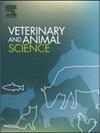Morbidity, mortality, and risk factors associated with Theileria parva seropositivity in a longitudinal calf study, Narok, Kenya
IF 1.9
Q2 AGRICULTURE, DAIRY & ANIMAL SCIENCE
引用次数: 0
Abstract
East Coast fever (ECF), caused by Theileria parva causes devastating loss to livestock keepers in sub-Saharan Africa. A longitudinal study was carried out in Narok County to estimate the incidence and risk factors associated with Theileria parva infection among calves. Calves were recruited within 5 weeks of birth and visited every six weeks to collect farm and calf level factors. A total of 1849 serum samples were collected and tested using an indirect enzyme-linked immunosorbent assay (ELISA). A multilevel multivariable logistic regression was used to determine associations between the seropositivity and different predictor variables. A total of 318 calves were recruited where 62 seroconverted during the follow up period. The overall risk of exposure was 26 %, with ECF-specific morbidity risk of 14.5 %. The cumulative incidence rate was 37 cases per 100 calf-years with higher incidence rate in agro-pastoral system. The crude mortality risk was 5.1 %, but four calves manifested classical signs of ECF resulting to clinical case-fatality risk of 44.4 %. In the final multivariable model, four variables were found to be significantly associated with T. parva seropositivity; calf age (OR 6.9; P < 0.01), calf sex (OR 1.4; P = 0.02), acaricide application (OR 0.5; P < 0.01) and spraying specific body parts (OR 2.5; P = 0.002). The results present the T. parva exposure patterns based on serological response in calves from birth to one year. These results will support evidence-based and effective practices for the management and control of ECF to mitigate the impact on productivity in the livestock sector.
在一项纵向小牛研究中,发病率、死亡率和与细小芽孢杆菌血清阳性相关的危险因素,Narok,肯尼亚
由细小芽孢杆菌引起的东海岸热(ECF)给撒哈拉以南非洲的牲畜饲养者造成了毁灭性的损失。在纳罗克县进行了一项纵向研究,以估计犊牛细小芽孢杆菌感染的发生率和相关危险因素。在出生5周内招募小牛,每6周访问一次以收集农场和小牛水平的因素。共收集1849份血清样本,采用间接酶联免疫吸附试验(ELISA)进行检测。采用多水平多变量逻辑回归来确定血清阳性与不同预测变量之间的关系。总共招募了318头小牛,其中62头在随访期间血清转化。总体暴露风险为26%,ecf特异性发病风险为14.5%。累计发病率为37例/ 100年,农牧系统发病率较高。粗死亡率风险为5.1%,但4头小牛表现出典型的ECF症状,导致临床病死率风险为44.4%。在最后的多变量模型中,发现4个变量与细小绦虫血清阳性显著相关;犊牛年龄(OR 6.9;P & lt;0.01),小牛性别(OR 1.4;P = 0.02),杀螨剂应用(OR 0.5;P & lt;0.01)和喷洒特定身体部位(OR 2.5;P = 0.002)。结果提出了基于犊牛从出生到一岁的血清学反应的细小绦虫暴露模式。这些结果将支持以证据为基础的有效做法来管理和控制ECF,以减轻对畜牧业生产力的影响。
本文章由计算机程序翻译,如有差异,请以英文原文为准。
求助全文
约1分钟内获得全文
求助全文
来源期刊

Veterinary and Animal Science
Veterinary-Veterinary (all)
CiteScore
3.50
自引率
0.00%
发文量
43
审稿时长
47 days
 求助内容:
求助内容: 应助结果提醒方式:
应助结果提醒方式:


